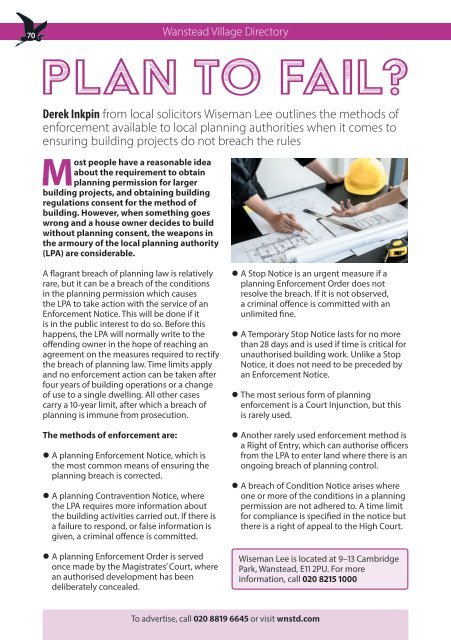September 2021
You also want an ePaper? Increase the reach of your titles
YUMPU automatically turns print PDFs into web optimized ePapers that Google loves.
70<br />
Wanstead Village Directory<br />
plan to fail?<br />
Derek Inkpin from local solicitors Wiseman Lee outlines the methods of<br />
enforcement available to local planning authorities when it comes to<br />
ensuring building projects do not breach the rules<br />
Most people have a reasonable idea<br />
about the requirement to obtain<br />
planning permission for larger<br />
building projects, and obtaining building<br />
regulations consent for the method of<br />
building. However, when something goes<br />
wrong and a house owner decides to build<br />
without planning consent, the weapons in<br />
the armoury of the local planning authority<br />
(LPA) are considerable.<br />
A flagrant breach of planning law is relatively<br />
rare, but it can be a breach of the conditions<br />
in the planning permission which causes<br />
the LPA to take action with the service of an<br />
Enforcement Notice. This will be done if it<br />
is in the public interest to do so. Before this<br />
happens, the LPA will normally write to the<br />
offending owner in the hope of reaching an<br />
agreement on the measures required to rectify<br />
the breach of planning law. Time limits apply<br />
and no enforcement action can be taken after<br />
four years of building operations or a change<br />
of use to a single dwelling. All other cases<br />
carry a 10-year limit, after which a breach of<br />
planning is immune from prosecution.<br />
The methods of enforcement are:<br />
• A planning Enforcement Notice, which is<br />
the most common means of ensuring the<br />
planning breach is corrected.<br />
• A planning Contravention Notice, where<br />
the LPA requires more information about<br />
the building activities carried out. If there is<br />
a failure to respond, or false information is<br />
given, a criminal offence is committed.<br />
• A planning Enforcement Order is served<br />
once made by the Magistrates’ Court, where<br />
an authorised development has been<br />
deliberately concealed.<br />
• A Stop Notice is an urgent measure if a<br />
planning Enforcement Order does not<br />
resolve the breach. If it is not observed,<br />
a criminal offence is committed with an<br />
unlimited fine.<br />
• A Temporary Stop Notice lasts for no more<br />
than 28 days and is used if time is critical for<br />
unauthorised building work. Unlike a Stop<br />
Notice, it does not need to be preceded by<br />
an Enforcement Notice.<br />
• The most serious form of planning<br />
enforcement is a Court Injunction, but this<br />
is rarely used.<br />
• Another rarely used enforcement method is<br />
a Right of Entry, which can authorise officers<br />
from the LPA to enter land where there is an<br />
ongoing breach of planning control.<br />
• A breach of Condition Notice arises where<br />
one or more of the conditions in a planning<br />
permission are not adhered to. A time limit<br />
for compliance is specified in the notice but<br />
there is a right of appeal to the High Court.<br />
Wiseman Lee is located at 9–13 Cambridge<br />
Park, Wanstead, E11 2PU. For more<br />
information, call 020 8215 1000<br />
To advertise, call 020 8819 6645 or visit wnstd.com

















